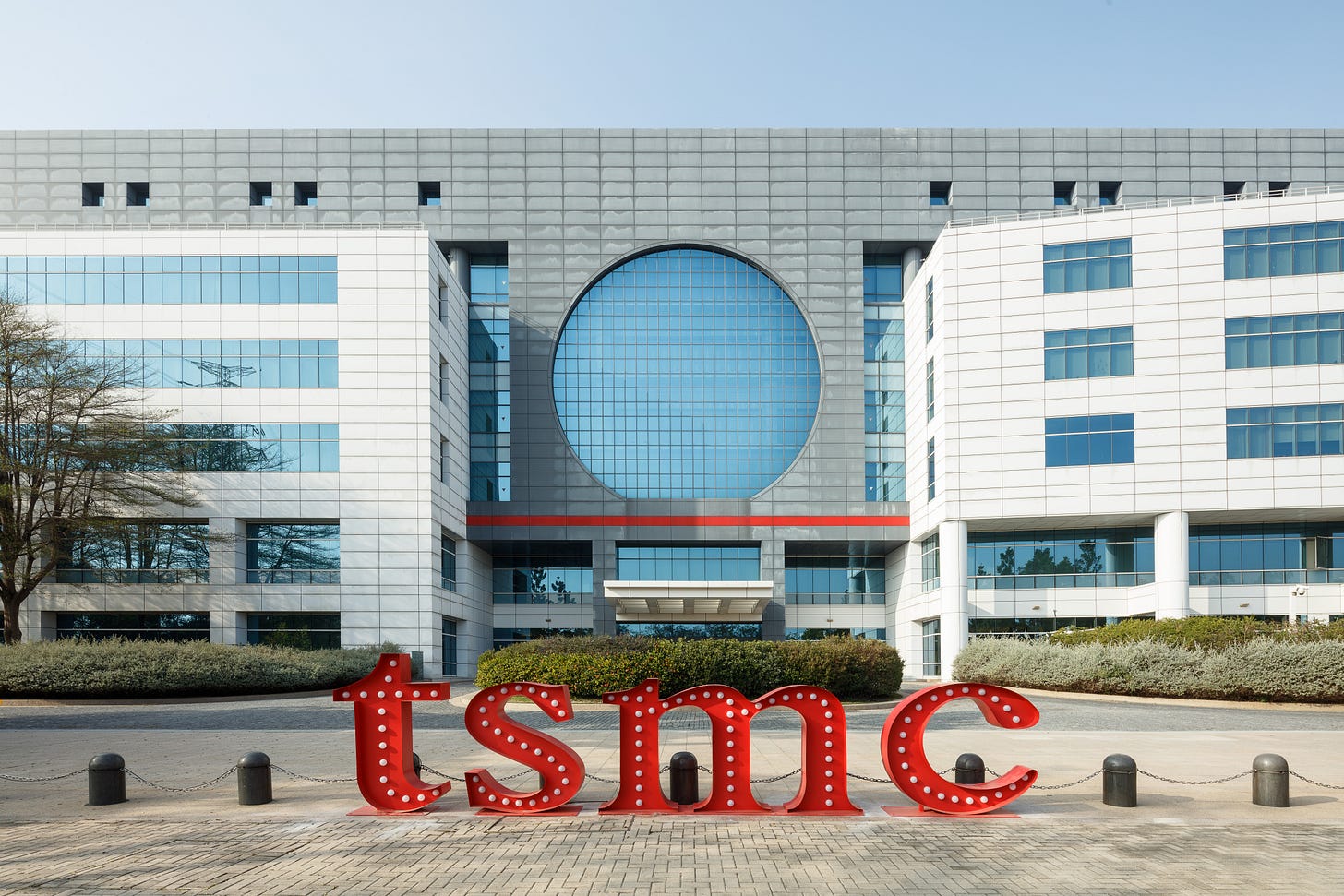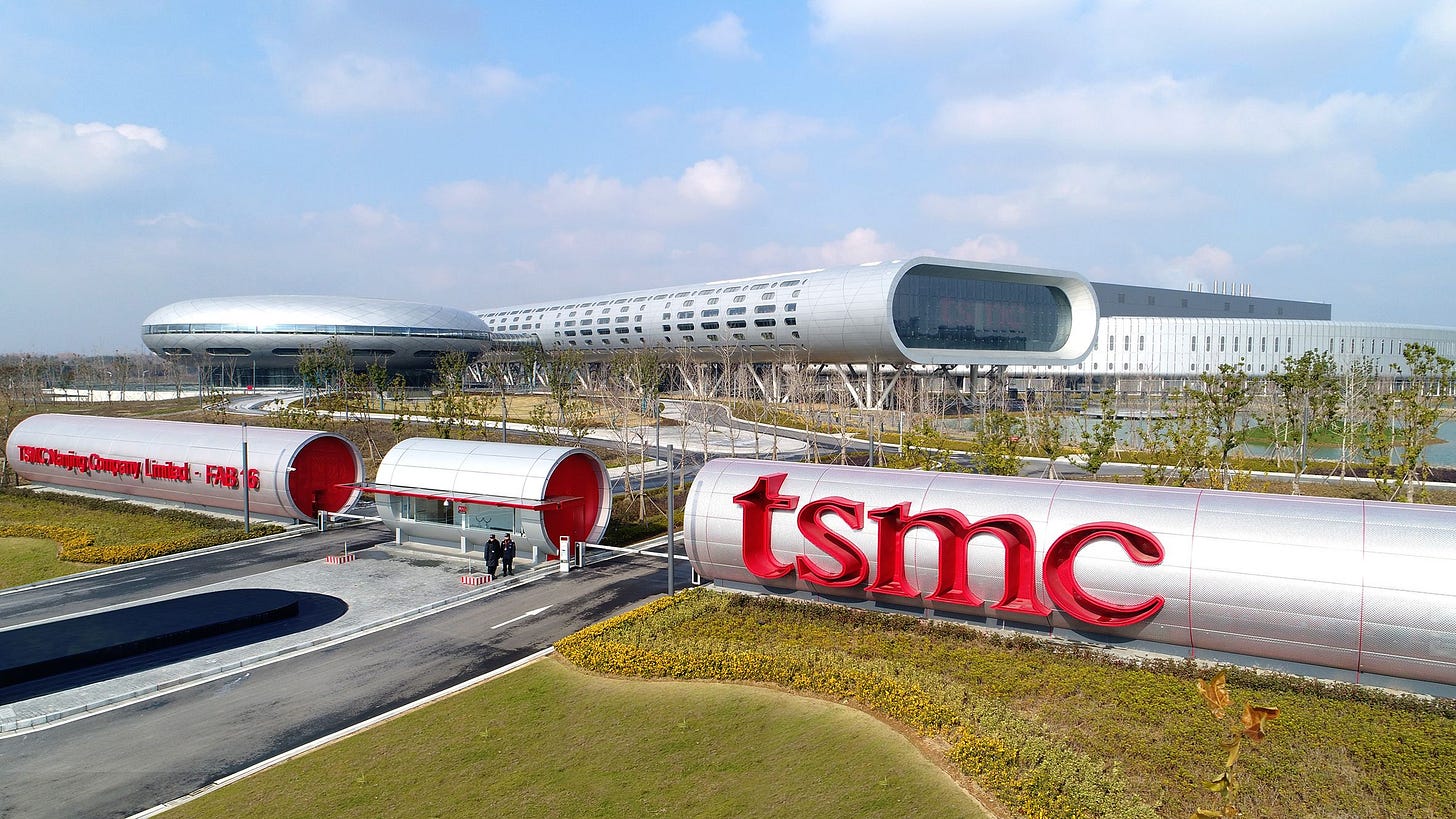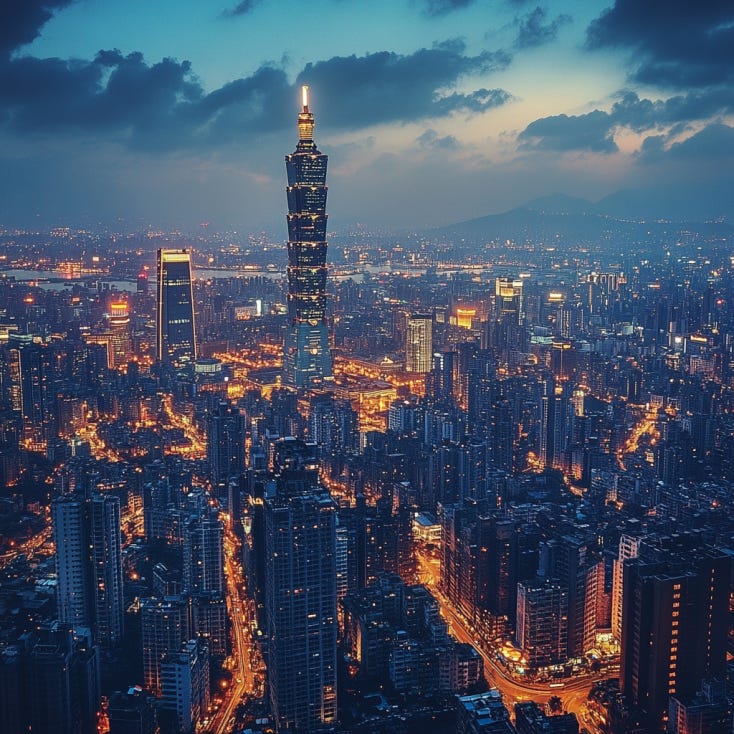TSMC Would Not Have Emerged in the U.S. - Even with Morris Chang (Debunking the Semiconductor Myth)
Debunking the idea that TSMC (or a similar company) would've formed in the U.S. if Morris Chang were incentivized to never leave the U.S.
The undisputed #1 semiconductor champion of the world in 2025 is TSMC (Taiwan Semiconductor Manufacturing Company), commanding >60% of the global foundry market and >90% of the most cutting-edge/advanced chips market.
Often hailed as the linchpin of Taiwan’s high-tech economy, TSMC’s rise has given rise to a persistent rumor: “If Morris Chang had been incentivized to stay in the U.S. — a TSMC-like company would exist as a U.S. company” (same level of global dominance).
This is likely BS. I’m all for retaining elite talent, and think the U.S. gov has historically fumbled a lot of talent, but thinking that a TSMC variant would’ve definitely emerged in the U.S. solely based on retention of Chang is delusional.
Morris Chang: Could the U.S. have done more to retain Chang? Maybe. High IQ and was already objectively successful in the U.S. at Texas Instruments. While it’s possible Chang might’ve built up a U.S.-variant of TSMC, this scenario seems extremely unlikely.
TSMC: Probably would’ve emerged in some variation in Taiwan regardless of whether Morris Chang stayed in the U.S. Chang’s vision and experience likely accelerated TSMC development to a significant extent, but Taiwan probably creates a high-level semiconductor company (TSMC) no matter what.
TSMC’s Lead in Semiconductor Manufacturing (2025)
TSMC maintains a pronounced lead over its rivals through technological superiority, market dominance, and massive strategic investments.
Process Technology Leadership
2nm Node (2025):
TSMC’s N2 process is scheduled to enter mass production in late 2025, leveraging gate-all-around (GAA) nanosheet transistors.
Expected performance gain of ~15% and 25–30% better power efficiency compared to its 3nm node.
This timeline places TSMC approximately 12–18 months ahead of both Intel and Samsung in advanced node deployment.
1.6nm Roadmap:
TSMC plans to introduce its A16 (sometimes called N1.6) node in late 2026 with backside power delivery.
Targets a 20% power reduction and 10% performance boost over N2.
Market Share Dominance
TSMC controls 66% of the pure-play foundry market in 2025—up from around 59% in 2023—dwarfing Samsung’s 9.1% and Intel’s nascent foundry efforts.
In advanced nodes (≤7nm), TSMC holds roughly 90% market share for AI/HPC chips, supplying top-tier customers like Apple, Nvidia, AMD, and hyperscalers.
Financial & Production Scale
Revenue Growth: Forecasting 24–26% year-over-year growth in 2025, TSMC anticipates $38B–$42B in capital expenditures—nearly triple the broader semiconductor industry’s ~10% growth outlook.
Capacity Commitment: 2nm capacity is fully booked through 2025, with six fabs in Taiwan and Arizona dedicated to 2nm production.
Advanced Packaging (Chip-on-Wafer-on-Substrate)
TSMC’s 3D packaging capacity will double to 660,000 units in 2025, crucial for AI accelerators like Nvidia’s H200/H100.
Competitors lack equivalent high-volume integration capabilities for HBM4 memory and chiplet architectures.
Geopolitical Resilience
Plans include up to 10 new fabs by 2025 across Taiwan, Arizona (USA), Japan, and Germany, backed by $38B in capex.
Maintains over 90% utilization rates for advanced nodes despite U.S.-China trade tensions.
TSMC’s 2–3 year lead in advanced process technology, bolstered by unmatched scale, packaging innovations, and strategic client partnerships, cements its dominance.
While Samsung and Intel aim to close the gap in the 2026–2027 timeframe, TSMC’s $40B+ annual R&D and capex budget and ~66% foundry market share make it the uncontested leader at least through the mid-2020s.
Who is Morris Chang? (TSMC Founder)
Morris Chang is widely regarded as the visionary architect behind Taiwan’s semiconductor revolution and the founder of TSMC, the world’s leading pure‑play semiconductor foundry.
Born in 1931 in Ningbo, China.
Moved with his family to Hong Kong during his youth, adapting to a multicultural environment.
Higher Education in the U.S.
Arrived in the United States in 1949.
Spent one year at Harvard before transferring to the Massachusetts Institute of Technology (MIT), where he earned both his bachelor’s and master’s degrees in mechanical engineering.
While working full‑time at Texas Instruments (TI), he pursued and obtained a Ph.D. in electrical engineering from Stanford University, establishing his deep expertise in semiconductor process technology.
Career at Texas Instruments (1958–1983)
Rapid Ascent
Joined TI in 1958 and gradually rose through the ranks, eventually overseeing TI’s global semiconductor business.
Known for his ability to bridge detailed fabrication know‑how with strategic management, he played a key role in designing manufacturing processes, improving yields, and scaling chip production.
Setbacks & Realizations
Despite his significant contributions and technical brilliance, Chang was repeatedly passed over for the CEO role at TI.
Internal politics and the company's shifting focus toward consumer products (like digital watches and calculators) sidelined his semiconductor vision.
Recruitment by Taiwan’s ITRI & the Birth of TSMC
Recruited in 1985
Taiwan’s Industrial Technology Research Institute (ITRI), intent on modernizing the nation’s economy, invited Chang to help elevate its nascent semiconductor program.
At that time, Taiwan was transitioning from labor‑intensive industries to higher-value technology production, and Chang’s expertise was seen as the catalyst needed for this transformation.
Founding of TSMC in 1987
With substantial backing from the Taiwanese government (which provided nearly 50% of TSMC’s initial $100 million capitalization) and strategic partnerships (notably with Philips), Chang founded TSMC.
He pioneered the “pure‑play” foundry model—focusing exclusively on manufacturing while leaving chip design to fabless companies. This strategy diverged sharply from the traditional integrated device manufacturer (IDM) approach predominant in the U.S.
Transformative Leadership at TSMC
Pure‑Play Foundry Model: Chang’s vision allowed TSMC to become a neutral, high‑quality manufacturing partner for global fabless companies. This innovative model unlocked rapid innovation and cost efficiencies.
Operational Rigor & Culture: He instituted rigorous process management and yield optimization practices. His insistence on resolving issues even at 2 A.M. exemplified the relentless, round‑the‑clock operational discipline that became a TSMC hallmark.
Strategic Partnerships & Global Trust: Chang leveraged his international credentials and industry expertise to secure pivotal partnerships with companies such as Philips, Apple, Nvidia, and Qualcomm. These alliances provided the technological transfers, capital, and market credibility necessary for TSMC’s rapid expansion.
Market Transformation: Under his leadership, TSMC grew to command over 50% of the global foundry market and nearly 90% of the most advanced nodes, reshaping the semiconductor industry worldwide.
Legacy & Impact
Accelerated Growth: Chang transformed TSMC from a state‑backed initiative into a global semiconductor powerhouse, achieving breakthroughs in yield optimization and cost efficiency that set new industry standards.
Global Dominance: His strategic vision and operational discipline propelled TSMC to become indispensable to major tech companies worldwide.
Enduring Influence: While Taiwan’s inherent advantages—robust government support, a low‑cost, high‑skill workforce, and a collaborative ecosystem—would likely have produced a semiconductor foundry regardless, Chang’s unique leadership accelerated and amplified this success beyond what might have been achieved by any other leader.
Common Myth: Keeping Morris Chang in the U.S. = U.S. Semiconductor Dominance (“TSMC” in U.S.)
The Claim: If the U.S. had provided Morris Chang with ample funding and strong policy support—thereby retaining him—the country would have birthed a TSMC-like semiconductor giant, leading to U.S. dominance in advanced chip manufacturing.
In this narrative, the U.S. is said to have “lost” TSMC by not recognizing Chang’s potential.
Why the Myth Persists:
Chang’s American Ties: Chang’s education and early career in the U.S. (Harvard, MIT, and Texas Instruments) give him the aura of an “American-trained” executive.
Historical U.S. Leadership: Early semiconductor breakthroughs by U.S. companies like Intel, IBM, TI, and Motorola suggest that another world-class leader might have emerged domestically.
Simplistic Hero-Founder Narrative: Many retellings focus solely on Chang’s individual brilliance while overlooking the structural forces at work.
Why this thinking is too simplistic…
Different Policy Environments (U.S. vs. Taiwan)
In the 1980s, American federal support for microelectronics was channeled primarily through defense and space research contracts, not through initiatives to create commercial foundries.
In contrast, Taiwan’s government pursued a coordinated industrial strategy—providing tax incentives, R&D institutes, and the creation of science parks—to transform the island into a semiconductor hub.
Structural Advantages in Taiwan
Capital & Cost: Taiwan’s low-cost, high-precision workforce and streamlined regulations created an environment ideal for advanced manufacturing.
Government Backing: Nearly 50% of TSMC’s initial $100 million capitalization came directly from the Taiwanese government, with additional support from foreign partners like Philips.
Ecosystem Clustering: The establishment of Hsinchu Science Park enabled the co-location of chip design houses, packaging firms, and equipment suppliers, creating a self-reinforcing cycle of innovation.
Market Readiness
In the U.S. of the 1980s, integrated device manufacturers (IDMs) dominated the market. Outsourcing was seen as an “overflow” solution rather than a strategic partnership, and there was little appetite for a pure‑play foundry model.
Early fabless startups in Silicon Valley, which eventually became TSMC’s major customers, were not yet prevalent.
The Truth re: TSMC Formation in Taiwan
A.) Government-Driven Industrial Policy
TSMC was NOT an entrepreneurial roll-of-the-dice but a critical component of Taiwan’s national development plan. The government, via the Industrial Technology Research Institute (ITRI) and strategic partners (notably Philips), provided:
Substantial Capital: TSMC’s initial $100 million funding—with nearly 50% from the government—gave it a financial foundation unmatched in the U.S.
Infrastructure Support: The creation of Hsinchu Science Park clustered critical semiconductor-related industries, reducing logistical hurdles and fostering innovation.
B.) The Pure-Play Foundry Model
Morris Chang’s vision was to create a foundry that focused solely on manufacturing—eschewing in-house design. He likely would not have been able to do this outside of Taiwan. This model allowed TSMC to:
Optimize Yields and Lower Costs: By channeling all resources into manufacturing excellence, TSMC achieved rapid improvements in process yields and cost efficiency.
Build a Global Customer Base: Its neutral, high-quality manufacturing attracted anchor customers such as NVIDIA, Qualcomm, and Apple.
C.) Strategic Timing & Market Dynamics
TSMC’s rise coincided with a global surge in demand for personal computers, mobile devices, and later AI-related chips. This timing created a virtuous cycle:
Reinvestment in R&D: State support allowed TSMC to continuously invest billions in process innovations.
Ecosystem Synergy: As consumer tech boomed, more fabless companies emerged, fueling TSMC’s growth and global market penetration.
What if the U.S. had retained Morris Chang?
Likely: Executive role in a HPC/tech company.
Unlikely: A TSMC-like entity is founded by Chang in the U.S.
If Chang remained in the U.S. — he probably would’ve been hired by some tech/hardware company as an executive. It is unlikely he would’ve opted to found a company akin to TSMC.
1. Challenges in the U.S. Environment
Capital-Intensive Fabs: Building state-of-the-art fabs required hundreds of millions to billions of dollars—a scale that 1980s U.S. venture capital was reluctant to support for manufacturing ventures.
Higher Labor Costs & Rigid Regulations: The U.S. had significantly higher wages and more stringent labor laws, eroding the cost advantages essential for a pure‑play model.
Entrenched IDM Culture: Dominant U.S. firms like Intel and TI were deeply invested in integrated models and were skeptical of outsourcing fabrication.
2. Probable Career Paths for Chang in the U.S.
Within an IDM: Chang might have driven process improvements internally, but transforming a large IDM to adopt a pure‑play foundry model would have been an uphill battle.
Boutique Foundry or Defense Contracts: He might have launched a smaller foundry focused on niche markets (e.g., for defense), but scaling to a global powerhouse like TSMC would likely have been unachievable.
3. Estimated Impact
Global Dominance: Even with Chang’s leadership, a U.S.-based foundry would likely have struggled to achieve TSMC’s ~66% market share in advanced nodes. Structural hurdles would have limited its global dominance.
Alternative Leadership in Taiwan: Taiwan’s government would almost certainly have recruited another elite leader (≈80% likelihood). However, if we benchmark Chang’s impact at “100 points,” a replacement might have delivered only 70–80 points—resulting in a foundry that captured perhaps 40–45% of the market instead of >60%.
Would Taiwan have developed a TSMC-like company without Morris Chang? (Critical thinking)
Historical evidence shows that Taiwan’s semiconductor authorities were aware of the pure‑play concept before Chang’s arrival. For instance, Caltech’s Carver Mead had floated similar ideas to ITRI in the early 1980s.
However, without Chang’s decisive intervention, Taiwan’s leadership might have struggled to shift from their fragmented, low-margin assembly and packaging approach to a focused, pure‑play strategy.
Given these factors, there’s probably a ~65% chance that Taiwan would have eventually conceptualized a pure‑play foundry model on its own.
Execution without Chang:
The successful execution of the pure‑play foundry model demanded not only a strategic pivot but also exceptional operational leadership—qualities that Chang uniquely embodied through his experience at Texas Instruments.
Taiwan’s ecosystem (with its low-cost, high-skill workforce, robust government backing, and collaborative culture) was well-suited to implement such a model.
However, in the absence of Chang, even if another elite leader had been recruited (an estimated 80% probability given Taiwan’s urgent national ambitions), that replacement might have delivered only 70–80% of Chang’s transformative impact.
Estimated Market Impact:
Under Chang’s Leadership: TSMC eventually achieved ~60% global market share in advanced nodes.
With an Alternative Leader: The foundry might have reached only ~40–45% market share, translating into slower growth and less aggressive global dominance.
Everything considered, we can be reasonably confident that Taiwan would have formed a dedicated, pure‑play foundry even without Morris Chang.
However, while the structural advantages of Taiwan would have supported such a venture, the absence of Chang’s exceptional vision and execution would likely have resulted in a significantly less dominant player on the global stage.
Taiwan’s inherent strengths almost guarantee the eventual emergence of a TSMC-like entity, but Morris Chang’s leadership accelerated and amplified that success to levels that might have been 20–30% lower under a different leader.
Final Take: Morris Chang, U.S. Talent Retention, U.S. Fabs
It is possible that some version of “TSMC” could’ve popped up in the U.S. if Morris Chang had been incentivized to stay in the U.S.
However, this logic assumes the U.S. gov and/or investors would’ve backed his vision AND that the U.S. workforce output would’ve matched that attained in Taiwan (extremely unlikely).
TSMC’s “pure-play” vision was Chang’s idea and his strategy/execution were impeccable — but he was heavily subsidized/backed by the Taiwanese government, private corporations, and a Taiwanese workforce (high IQ, hard working, low cost) with an elite cost-output ratio.
The synergy of these variables (Chang + $$$ backing from gov/corps + Taiwanese workers: output/pay) led TSMC to crush the competition and achieve juggernaut status.
Would a TSMC-esque entity have emerged in Taiwan without Chang? Probably. Would they have emerged as rapidly, been as productive, or become as dominant? Probably not to the extent we know.
In fact, some claim that hopes of Taiwan dominating semiconductors would’ve been nothing more than a historical footnote without Chang. (Not sure I’d go that far.)
Anyways, my thoughts:
The U.S. should aim to retain elite talent (like Morris Chang) if possible (Could they have retained Chang? Not so sure.)
Keeping Morris Chang probably doesn’t mean the U.S. has a homegrown TSMC-like entity that dominates semiconductor manufacturing
Taiwan would’ve likely produced a quality semiconductor company regardless of Morris Chang
Taiwan would probably be less successful than they are today without Chang spearheading TSMC
And for those who say: “see the U.S. TSMC fabs are kicking ass now”… well so what? This is not proof that Chang could’ve efficiently built TSMC into a U.S. pure-play semiconductor powerhouse.
To get TSMC as we know it in 2025, you needed: Chang (calling the shots), heavy funding (gov & private), and the robotic Taiwanese workers (low pay, high output, high IQ, precise).
Now that most operations are perfected and streamlined, they can expand operations to the U.S. and diversify production.






